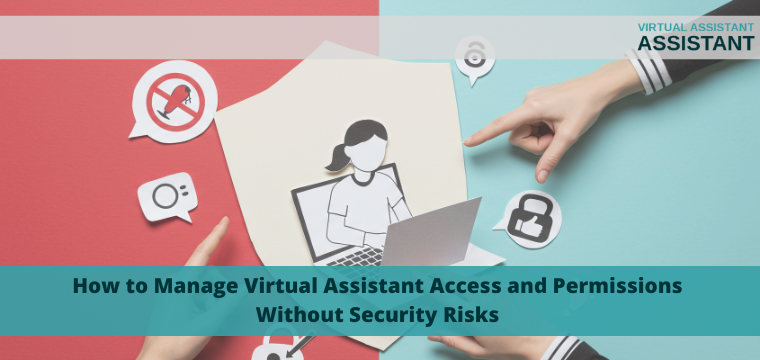
How to Manage Virtual Assistant Access and Permissions Without Security Risks
Did you know that over 60% of small businesses accidentally expose sensitive data when working with remote workers, including virtual assistants?
It usually starts with something simple, sharing one password too many or forgetting to revoke access after a project ends.
Virtual assistants can supercharge productivity, but without proper access control, they can also create hidden security gaps that put your business at risk.
I’ve spent five years helping companies secure their remote teams, and I’ve seen the same mistakes repeatedly: shared passwords, unlimited permissions, and ghost accounts that never get closed.
After auditing over 200 businesses, I’ve identified the exact framework that prevents these disasters. This guide shows you how to give your VAs the access they need without the security risks you can’t afford.
No technical jargon. Just practical steps you can implement today.
Table of Contents
The Real Risks You’re Taking
When you hire a virtual assistant, you’re trusting them with your business. That’s fine.
But trust doesn’t mean giving unlimited access to everything.
VAs work remotely. They use their own devices. They might work for multiple clients.
Some use public WiFi. Others share computers with family members.
Here’s what goes wrong:
- Shared passwords get leaked or reused across multiple clients
- VAs keep access long after their contract ends
- Nobody tracks what VAs actually do in your systems
- One compromised VA account gives hackers access to everything
The stakes get higher as you grow. One VA is manageable. Five VAs become complicated.
Ten VAs? You’ve lost control.
The 4 Principles of Secure VA Access Management
Stop making this harder than it needs to be. Follow these four rules and you’ll avoid most security problems.
1. Principle of Least Privilege
Your social media VA doesn’t need to see your financial records. Your bookkeeper doesn’t need access to customer support emails.
Start with zero access. Add permissions only when someone asks for them. Review what each VA has access to every quarter.
2. Use Role-Based Access Control (RBAC)
Don’t customize access for every single VA. That’s how you lose track.
Instead, create standard roles:
| Role | Systems They Access | Permission Level |
| Admin Support | Email, Calendar, Documents | Edit |
| Customer Service | CRM, Support Tickets, Chat | Edit |
| Social Media | Social Platforms, Canva | Post Only |
| Bookkeeping | Accounting Software | View + Record |
When you hire a new VA, assign them a role. Done.
3. Implement Time-Based Access
Hired a VA for a three-month project? Set their access to expire in three months.
Most businesses forget this step. They end up with dozens of old accounts sitting around. Each one is a security risk.
Automatic expiration forces you to review whether someone still needs access.
4. Maintain Complete Audit Trails
You need to know who changed what and when. Not just for security. For compliance, too.
Good audit logs show:
- When someone logs in
- What they access
- What they change
- Who approved their access
User management tools like Multiplier log every operation in your identity provider and tie it back to approval tickets. You’ll never wonder who gave access to what.
How to Actually Do This
Theory is useless without action. Here’s your step-by-step plan.
Step 1: Start with an audit.
List every system you use. Write down which VAs have access to each one. You may find VAs with access they don’t need. Remove it now.
Step 2: Stop sharing your passwords.
Create separate accounts for each VA. Use single sign-on if your tools support it. Each person gets their own login.
Step 3: Build a checklist.
When you onboard a new VA, follow the same steps every time:
- Create their account in your identity system
- Assign their role-based permissions
- Enable multi-factor authentication
- Set access expiration date
- Document everything
When a VA leaves, reverse the process immediately. Same day. No exceptions.
Step 4: Require multi-factor authentication everywhere.
Passwords alone don’t cut it anymore. Make every VA use an authenticator app.
Yes, it adds friction. That friction prevents breaches.
Tools and Automation
You don’t need to handle access control manually.
Here’s how technology can do the heavy lifting:
- Password managers for secure credential sharing (LastPass, 1Password)
- Identity management systems for user and group control
- Automation tools to handle onboarding and offboarding
Find reliable software solutions that let teams manage user attributes, group memberships, and permissions directly within project workflows, cutting down on IT workload and response time.
Final Thoughts: Start Today
Pick one thing from this article and do it today. Run an access audit. Set up multi-factor authentication. Create your first role-based permission set.
Security doesn’t happen overnight. But every step you take reduces your risk. Your business depends on virtual assistants. Make sure those assistants don’t become your biggest vulnerability.
The right systems make security automatic, not another item on your to-do list.
